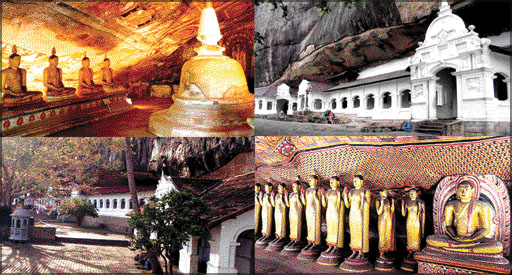The cave temple of Dambulla
 The
Dambulla Cave Temple or the Golden Temple of Dambulla (Rangiri Dambulu
Viharaya) is a World Heritage Site in Sri Lanka. This temple is situated
148 km east of Colombo, at Dambulla, which is 12 miles from Sigiriya. The
Dambulla Cave Temple or the Golden Temple of Dambulla (Rangiri Dambulu
Viharaya) is a World Heritage Site in Sri Lanka. This temple is situated
148 km east of Colombo, at Dambulla, which is 12 miles from Sigiriya.
It is the largest and best-preserved cave temple complex in Sri
Lanka. There are more than 80 documented caves in the surroundings.
The major attractions are spread over five caves, which contain
statues and paintings, which are related to the Buddha and His life.
There are a total of 153 Buddha statues, three statues of kings and four
statues of gods and goddesses. These include two statues of Hindu gods,
Vishnu and Ganesh. The murals cover an area of 2100 square metres.
Stories related to the Buddha depicted are on the walls. The cave
complex dates from the third and second centuries BC, when it was already established as one of the largest and
most important monasteries. King Valagambahu is believed to have
converted the caves into a temple in the First Century BC.
centuries BC, when it was already established as one of the largest and
most important monasteries. King Valagambahu is believed to have
converted the caves into a temple in the First Century BC.
Exiled from Anuradhapura, he sought refuge from South Indian usurpers
(people who had taken power wrongfully) for 15 years. After reclaiming
his capital, the King built a temple in grateful worship.
Many other kings built on this later, and by the 11th century, the
caves had become a major religious centre; they still are.
King Nissanka Malla gilded (covered with a thin layer of gold paint)
the caves and added about 70 Buddha statues in 1190. During the 18th
Century, the caves were restored and painted by Kandyan kings.
As mentioned above, the temple is composed of five caves, which have
been converted into shrine rooms. The caves, built at the base of a 150m
high rock during the Anuradhapura and Polonnaruwa period, are the most
impressive cave temple found in Sri Lanka.
The first cave is called Devaraja Lena (cave of divine kings). An
account of the founding of the monastery is recorded in a first century
Brahmin inscription over the entrance to the first cave. There is a 14
metre Buddha statue in this cave, carved out of the rock.
It has been re-painted many times in history, and the last time is
known to be in the 20th Century. At His feet is Buddha's favourite
pupil, Ananda; at His head, Vishnu, said to have used his divine powers
to create these caves.
In the second and largest cave, in addition to 16 standing and 40
seated statues of Buddha, are statues of the gods Saman and Vishnu, and
statues of Kings Vattagamini, who honoured the monastery in the First
Century BC and Nissanka Malla, responsible for the gilding of 50 statues
in the 12th Century, as indicated by a stone inscription near the
entrance.
This cave is known as Maharaja Lena (cave of great kings). The Buddha
statue carved out of rock on the left side of the cave is escorted by
wooden figures of the Bodhisatva Maitriya and Avalokitheshwara.
There is also a dagoba and a spring, which drips water that is said
to have healing powers, out of a crack in the ceiling. Valuable
paintings on the cave ceiling dating from the 18th Century depict scenes
from the Buddha's life, from the dream of Mahamaya to temptations, by
the demon Mara. Further pictures depict important events from history.
The third cave, the Maha Alut Vihara (great new monastery) acquired
ceiling and wall paintings done in typical Kandyan style during the rule
of King Kirthi Sri Rajasinghe (1747-1782). In addition to the 50 Buddha
statues, there is also a statue of the king.
The fourth and fifth caves are smaller, they date from a later period
and are not of such high quality.
This temple is one of the greatest and most popular temples in Sri
Lanka, which will not be missed by any devotee.
Janani Amarasekara |
